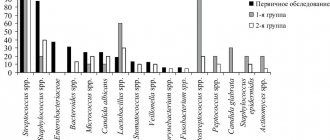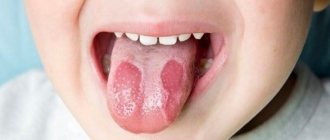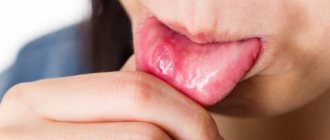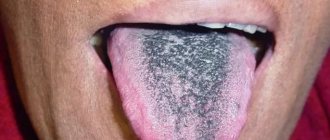Causes of gray plaque on the tongue
A substrate that has a high density is considered truly suspicious and dangerous. We list the serious reasons for the appearance of gray plaque:
- Most often, accumulations appear due to gastrointestinal ailments.
- The surface of the muscular organ becomes covered with a film in those patients who have undergone antibiotic therapy.
- With HIV infection, a gray coating forms on the tongue, as the gastrointestinal tract suffers.
- A disease such as tonsillitis provokes pathological layers. They appear due to the proliferation of harmful microorganisms that emit an unpleasant odor.
- The reasons may lie in dehydration of the body and an increase in temperature.
- It is also bad when there is excess water in the body. Water-salt metabolism is disrupted, the substrate becomes sticky, as the mucous layer inside the body increases in volume.
Very often, the tongue becomes grayish due to insufficient oral hygiene, as well as against the background of pneumonia or bronchitis. By the way, a green coating on the tongue and bitterness in the mouth is formed due to massive accumulations of bile. Usually the problem occurs against the background of pathology of the biliary system.
Diseases of the stomach and intestines
These organs are directly involved in the digestive processes, so any disturbances in their functioning can lead to the appearance of bad breath, changes in taste perception and the formation of a grayish coating on the surface of the tongue. The oral cavity and pharynx are the initial sections of the digestive tract, and their condition is closely related to the functioning of the stomach and intestines. Listed below are the main pathologies of the gastrointestinal tract that can cause such symptoms, as well as traditional treatment regimens for these diseases.
Gastritis
Gastritis – millions of people suffer from this disease in various forms. In fact, the term “Gastritis” includes many diseases leading to inflammation of the stomach. In any case, if pain appears in the upper left region of the abdomen, then everyone categorically diagnoses themselves and their friends as gastritis. In this article we will try to help you understand the causes of gastritis, their symptoms and methods of effective treatment.
In the clinical diagnosis of acute gastritis, everything is obvious:
- Soreness in the left hypochondrium has the character of aching pain, sometimes with periods of cramping exacerbations in the form of cutting attacks.
- Heartburn is usually characteristic of gastritis caused by reflux or increased stomach acidity.
- Nausea and vomiting - sometimes this is the only possible way to reduce excess stomach acidity. However, vomiting is not as common with gastritis as the first two symptoms.
- Bloating. For the digestive system, which operates on the principle of a disassembly conveyor, it is important that all necessary enzymatic and chemical influences are carried out at all stages of digestion.
- Increased appetite is due to the fact that after eating, the acidity of the stomach temporarily decreases. However, in the case of severe damage to the stomach, eating can only increase pain, which leads to a reflex loss of appetite.
Treatment of gastritis should be preceded by a full examination to identify the causes of stomach inflammation. Only by finding out the cause of the pathology will it be possible to adequately treat it. However, in the acute period, symptomatic treatment is prescribed. This is done in order to reduce stomach pain and stop or reduce the body's inflammatory response. To do this, first of all, it is necessary to reduce the aggressiveness of gastric juice. And this can be achieved by following a diet and using drugs that reduce the production of hydrochloric acid or neutralize acidity in the lumen of the stomach.
The traditional treatment regimen for gastritis is shown in the table below.
Table. Drugs for the treatment of inflammation in the stomach
| Pharmacological group | Drugs |
| Antibiotics | "Clarithromycin", "Amoxicillin", "Tetracycline". |
| Antimicrobials | "Metronidazole". |
| Bismuth preparations | “Ventrisol”, “Tribimol”, “Vicalin”, “De-Nol”. |
| PPIs (proton pump inhibitors) | "Omeprazole", "Orthanol", "Omitox", "Rabeprazole". |
| Antacids | "Gaviscon", "Gastal", "Rennie", "Maalox". |
| Vitamins | vitamin P, vitamin U. |
Gastritis is a serious precancerous disease, so you should not try to diagnose yourself and treat the pathology at home. In the absence of adequate therapy, the risk of developing gastrinoma (a malignant tumor that produces gastrin) increases 4 times.
Gastroduodenitis
Gastroduodenitis is the most common complication of gastritis, when descending infection occurs and the duodenum is involved in the inflammatory process. In total, there are three forms of gastroduodenitis:
- superficial (the mucous membrane turns red and swells);
- hypertrophic (epithelial membranes thicken, multiple pinpoint hemorrhages appear on their surface);
- erosive (mucous membranes become ulcerated and covered with erosions).
Erosive gastroduodenitis is considered the most dangerous form of the disease, in which the risk of ulcerative damage to the gastrointestinal tract is more than 30%. The symptoms of the pathology are similar to those of gastritis, the only difference is the localization of the pain syndrome: with gastroduodenitis, it can shift from the epigastric region to the abdominal space. Also typical are changes in stool, which can manifest as sudden diarrhea (including profuse diarrhea) or prolonged retention of bowel movements.
The treatment regimen for gastroduodenitis includes drugs used to treat inflammatory processes in the stomach, but when selecting medications, etiological factors must be taken into account. If the cause of the disease is stress, the patient is prescribed sedatives and sedatives. With reduced secretion of hydrochloric acid, replacement therapy with digestive enzymes is indicated.
If the pathology has become chronic, auxiliary treatment is necessary, which is carried out outside of exacerbation attacks. It may include treatment with mud and mineral waters (sanatorium-resort treatment), physiotherapeutic methods, exercise therapy, massage and herbal medicine.
Colitis
Intestinal colitis (inflammation of the large intestine) is another disease in which a gray or off-white thin coating may form on the surface of the tongue. If the pathology occurs over a long period of time, the patient may not have any pronounced symptoms, so it is necessary to pay attention to atypical signs. These may be symptoms associated with a lack of vitamins and minerals due to impaired absorption in the colon: weight loss, dry skin and lips, hair loss, mood instability, loss of energy, anemia.
Almost always, simultaneously with the appearance of an unpleasant odor and changes in the appearance of the tongue, defecation disorders occur in the form of constipation or diarrhea. The smell of feces is fetid (less often sour).
Treatment of colitis in adults depends on the symptoms present and the results of the diagnosis. Drugs for treating uncomplicated colitis are listed in the table below.
Treatment of inflammation in the large intestine
| Pharmacological group | Drugs |
| Antimicrobials | "Nifuroxazide", "Enterofuril". |
| Intestinal sorbents | "Polifepan", "Enterosgel", "Neosmectin". |
| Laxatives | "Bisacodyl", "Magnesium sulfate", "Portalac". |
| Antidiarrheal drugs | "Imodium", "Loperamide". |
| Probiotics | “Normobakt”, “Bion-3”, “Yogulakt”, “Bifiform”. |
| Antibiotics | "Amoxicillin", "Azithromycin", "Tetracycline". |
| Antiparasitic agents | "Vermox", "Pyrantel". |
| Stimulators of regeneration and repair | "Methyluracil". |
| Antispasmodics | “Spazmol”, “Spazmalgon”, “No-shpa”. |
When diagnosed with ischemic intestinal colitis, patients are also prescribed drugs that prevent platelet aggregation and blood clot formation, for example, Pentoxifylline. To identify vascular ischemia of the colon, a coagulogram, intravenous angiography and blood tests are indicated.
Shades of gray plaque
Deposits may have different characteristics, covering the entire tongue or individual zones. When does a white-gray coating on the tongue indicate pathology?
- Dense and thick layer – diseases of the intestinal tract, which provoke constipation;
- Slippery, not very dense, but spread over the entire surface - this is a disruption of the liver and gastrointestinal tract;
- Thickenings at the back wall of the tongue - inflammation of the stomach or intestines;
- Whiteness around the edges and at the tip – lung diseases;
- Curdled accumulations covering both the tongue and the entire mouth - fungal infections (candidiasis) or stomatitis;
- Dryness on a pale gray background is an infection, which is accompanied by dehydration;
A dark gray coating on the tongue indicates the progression of the disease or the transition to a chronic form. So it’s not far from a critical state! It can occur with chronic gastroenteritis. The body may suffer from dehydration. A wet layer, on the contrary, indicates an excess of mucus. The dark shade is characteristic of severe epidemic diseases with fever. Too dark a color with a slight grayish tint is a symptom of cholera or Crohn's disease.
How to fight
In order to effectively deal with plaque on the tongue, the true cause of its appearance should be established. To do this, you should do a small test. In the morning, brush your teeth and tongue with a toothbrush and toothpaste, removing as much or as much plaque as possible from the surface of your tongue. Time it until it appears again. If less than three hours have passed, during which time you have not eaten or drunk anything, and it has already appeared and has a fairly dense structure, then it most likely indicates the presence of some kind of disease. If plaque begins to appear after three hours or after eating, this may indicate insufficient oral hygiene.
If plaque is a consequence of insufficient oral hygiene, it is necessary to thoroughly clean not only the surface of the tooth enamel and gums, but also the tongue and the inside of the cheeks.
Diagnostics
So, a grayish coating on the tongue can indicate many ailments. It is not easy to recognize the disease by the location of the film, color and consistency; one can only assume problems in the body. Therefore, to clarify the diagnosis, it is necessary to conduct diagnostic studies. First, the specialist interviews the patient and conducts an examination. If the situation requires it, the patient is sent for tests. He may be prescribed instrumental examinations, ultrasound, and gastroenterological examinations.
First, an adult needs to see a therapist, and the child’s parents should show the child to a pediatrician. In some cases, the patient is referred for consultation to specialized specialists. It could be:
- Infectious disease specialist;
- Otolaryngologist;
- Toxicologist;
- Pulmonologist;
- Dentist;
Dental plaque removal is often prescribed, since healthy plaque is the key to dental well-being. After all, layering is not an independent disease. This is a symptom, a sign of a particular illness.
Symptoms
The main symptom is a change in plaque color from light pink to gray .
If the disease is very severe, then the coating of the tongue is very dense, and the mouth begins to smell unpleasant. Gray and yellow color means that there are problems with the digestive system. Sometimes it is enough to adjust your diet to get rid of the problem.
It is necessary to exclude everything fried, salty and spicy, and it is better to lean on fresh vegetables and fruits. If after this the symptoms do not go away, you should contact a gastroenterologist to undergo an examination.
A rich yellow-gray tint indicates that the gallbladder or liver is not entirely healthy. In addition, this may indicate bile stagnation.
Gray coating on a child's tongue
As the child’s body is known, its mucous tissues are especially sensitive to pathological changes, even minor ones. Illnesses are immediately reflected in the receptor organ. A gray coating on a child’s tongue may indicate various diseases.
- Disturbances in the digestive tract. They are accompanied by vomiting, loose stools, pain and refusal to eat.
- Tonsillitis in the chronic phase leads to deposits not only on the tongue, but also in the throat. It is painful for the baby to swallow food, and the body temperature may rise.
- With scarlet fever, in the first days, the mucous membrane has gray deposits.
- Diphtheria provokes the formation of gray films. They cover both the palate and the throat. The disease is accompanied by a cough and is dangerous for complications.
In addition to these ailments, there are other pathologies. If the tongue is covered with a gray coating, this may mean that there are problems with the lungs, liver, and kidneys. This unpleasant phenomenon bothers the baby due to poor oral hygiene and stomatitis.
How to remove plaque from the tongue: techniques and treatments
Plaque cleaning is carried out in the classic hygienic way. The process can use the reverse (rough) side of a toothbrush or a special dental scraper.
The cleaning procedure is carried out in several stages:
- Place the toothbrush with the rough side facing your tongue;
- Apply toothpaste to the surface of the brush;
- Place the brush on the root of the tongue and clean off deposits with smooth movements;
- Rinse your mouth with running water.
This procedure is very effective for eliminating the natural whitish bacterial plaque that appears in most healthy people during sleep or during the working day, but to eliminate a specific “colored” plaque, you need to use special products: Miramistin (an antimicrobial/antiviral agent for green plaque ), peach oil (for yellow plaque), chlorophyllipt (for brown plaque), resorcinol 5% (for black plaque), hexetidine (for gray plaque).
It is worth understanding that the problem of “colored” plaque can be completely eliminated only after the underlying disease has been completely cured.
Treatment of gray plaque
It should immediately be noted that treatment consists of eliminating the root cause of the disease. To avoid dental problems, you should treat your teeth on time, systematically brush your tongue and rinse your mouth. It happens that a muscle organ becomes gray due to an unbalanced diet. It is enough to remove the errors and the layers will disappear. If a pathology of a specific organ is identified, then the disease should be treated by a corresponding specialist.
- For respiratory abnormalities, patients most often undergo a therapeutic course of antiviral drugs or antibiotics. Bronchitis, sinusitis, and tracheitis are often treated with physiotherapy.
- Problems with the digestive organs are solved depending on the nature of the illness. Antacids, enzymes, probiotics, and choleretic agents may be prescribed.
- If dehydration is diagnosed, the drinking regime is normalized and salt is limited.
- When the body's protective functions are reduced, vitamin complexes and immunostimulants will help.
- Candidiasis and stomatitis are treated with antiseptics and antifungal agents.
Do not self-medicate. Trust an experienced doctor. Depending on the illness, you will be prescribed antihistamines, antivirals, antimicrobials and other drugs. You may need a special diet, antispasmodics, or mineral water therapy. After proper treatment, deposits on the tongue disappear.
Diseases that cause plaque on the tongue:
- stomatitis;
- thrush (candidiasis). Caused by fungi of the genus Candida. The disease can be caused by long-term use of antibiotics or decreased immunity. With oral candidiasis, a typical manifestation is a dense milky-white coating that covers the tongue in spots. Similar spots may also appear on the roof of the mouth or gums. In severe cases, plaque covers the entire tongue as well as the walls of the throat, making swallowing and breathing difficult.
- scarlet fever. In the first days of the disease, the tongue is covered with a white-gray coating. Then the coating disappears, and the tongue acquires a crimson color;
- whooping cough. A pale yellowish coating on the tongue may be accompanied by bad breath;
- dysentery. A thick white coating is typical;
- cholera. Characterized by a dark coating (even black);
- diphtheria;
- gastritis;
- stomach ulcer;
- enterocolitis;
- pancreatitis;
- stomach cancer;
- kidney diseases;
- some other diseases.











